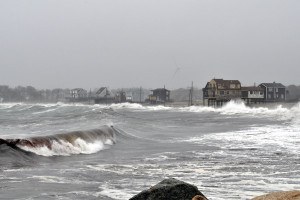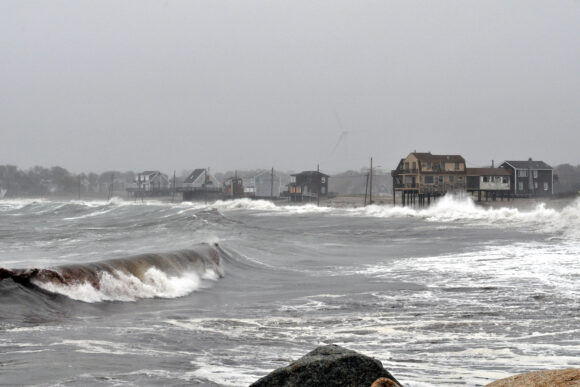The Jersey shore’s small vacation bungalows and cottages have for decades staked out little plots of paradise where families who scrimped and saved could while away summer evenings, parents having drinks on the deck and kids working the ice cream stand or stealing a first kiss under the boardwalk.
Now, nearly a year after Superstorm Sandy blasted through, countless middle-class families whose tiny vacation homes were once the place to make precious memories are finding them to be a financial albatross.

While billions of dollars in federal relief have helped primary homeowners rebuild after the storm, second homeowners find themselves stuck in limbo: not eligible for enough money to rebuild or even demolish their homes while they remain on the hook for mortgage payments and fatter flood insurance fees for houses they can’t even use.
“We thought we were good for the community, and to suddenly be labeled this second homeowner like it was a derogatory statement, it was like a smack in the face,” said Benita Kiernan, a retired nurse who with her retired New York City firefighter husband sank every spare cent into a small cottage on an inlet in Stafford Township.
“We became the scarlet-S second homeowners.”
For decades, the Jersey shore has been a place where police officers, plumbers, teachers and other working-class families can save up and put a down payment on a small beach bungalow to spend their summers “down the shore,” as it is called. In many cases the properties are passed down through families.
Even before Sandy tore the Kiernans’ home down to a wooden shell, it was not the palatial estate conjured by the phrase “vacation home.” But even then the modest 1,000-square-foot house had been a financial stretch – the family skipped dinners out and vacations to be able to afford it.
The sacrifice has been worth it, Kiernan said. The shore is where their grandchildren played, their four daughters packed in with their friends and the couple was considering moving full time because they viewed the community as a second hometown.
“It was low-key fun,” Kiernan said.
But the little house offers mostly heartache now. The Kiernans received about $100,000 from their insurance company, but that’s less than half of the amount of their policy and nowhere near enough to pay the mortgage and shoulder the cost of demolishing and rebuilding.
“This was our investment,” John Kiernan said as his wife wiped away tears.
Even tearing down the house and selling the lot is no easy way out – while homes have been selling on the Jersey shore, values are not what they were before the storm.
“Do I build it, do I leave it? I can’t even sell the property because properties have been downgraded that much,” he said.
Second homeowners are not eligible for a suite of relief options available to primary homeowners. Federal Emergency Management Agency rebuilding assistance, $1.8 billion in rebuilding funds the U.S. Department of Housing and Urban Development gave to New Jersey or low-interest loans from the Small Business Administration. Second homeowners will also see their flood insurance rates go up because they are not grandfathered in like primary homeowners.
In Lavallette, the skeleton of Cora Hoch’s sea glass-colored vacation bungalow remains, its foundation tipped, wiring exposed, doors missing and “do not enter” spray-painted on the side.
“We put our life savings into that little house,” said Hoch, a school nurse from Kearny, N.J. “We can’t afford to fix it, and FEMA will not give us anything.”
FEMA said the assistance money is meant to be a one-time stopgap measure to help people get back into their primary homes as soon as possible. Congress, FEMA said, set the rules.
“It was designed for those who don’t have a roof over their head or a place to live,” said Tom McDermott, a FEMA mitigation specialist. “I guess they said if they can afford a second home or a camp, and don’t take this the wrong way, it isn’t necessary that they get back up so they can enjoy a weekend or a week away.”
Second homeowners said the problem is that insurance doesn’t fully cover the price of the options for these homes. Rehabbing and, in many cases, lifting them or demolishing them and rebuilding from scratch.
“Everybody is in limbo because you can’t proceed to the next step,” said Benita Kiernan, whose neighborhood is now a patchwork of vacant damaged homes, freshly leveled lots and small ranch homes boosted up on stilts in an effort to keep them out of the water the next time a massive storm strikes.
Many are waiting to see if they can qualify for any other assistance, but aside from private charities there is little help. Some are dipping into their retirement funds.
Michelle and John Novella are rebuilding their Stafford Township home on their own, putting everything on credit cards.
“First homeowners should be the priority,” Michelle Novella said, but she feels second homeowners who patronize the seasonal businesses and make up the lifeblood of the Jersey shore should get something.
“Otherwise,” she said, “it’s going to make the Jersey shore very different.”
Was this article valuable?
Here are more articles you may enjoy.


 Munich Re: Insured Losses From Wildfires, Storms and Floods Hit Record High
Munich Re: Insured Losses From Wildfires, Storms and Floods Hit Record High  Palantir Poaching Suit Called ‘Scare’ Tactic by Ex-Employees
Palantir Poaching Suit Called ‘Scare’ Tactic by Ex-Employees  JPMorgan Wins Gender Pay Gap Dispute Against London Analyst
JPMorgan Wins Gender Pay Gap Dispute Against London Analyst  What The Return of California’s ‘Death Discount’ Means for Litigation
What The Return of California’s ‘Death Discount’ Means for Litigation 